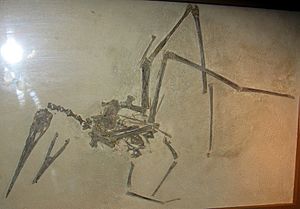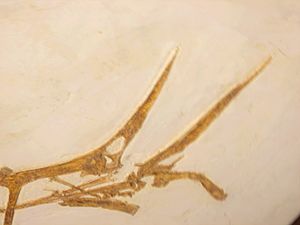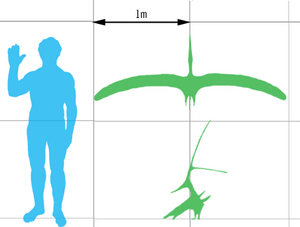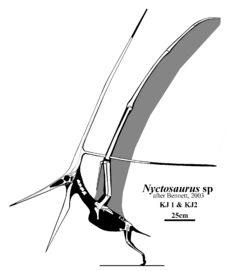Nyctosaurus facts for kids
Quick facts for kids NyctosaurusTemporal range: Upper Cretaceous
|
|
|---|---|
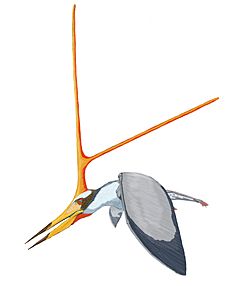 |
|
| Artist's impression of the crest | |
| Conservation status | |
|
Fossil
|
|
| Scientific classification | |
| Kingdom: | |
| Phylum: | |
| Class: | |
| Order: | |
| Suborder: | |
| Family: |
Pteranodontidae
|
| Genus: |
Nyctosaurus
Marsh, 1876
|
| Species | |
|
N. lamegoi |
|
| Synonyms | |
|
Nyctodactylus Marsh, 1881 |
|
Nyctosaurus (say: Nick-toe-SORE-us) was a type of flying reptile called a Pterosaur. Its name means "night lizard" or "bat lizard" because its wings looked a bit like a bat's. These amazing creatures lived during the late Cretaceous Period. Their fossils have been found in the mid-western United States. Back then, this area was covered by a large, shallow sea. Some Nyctosaurus even had a huge, antler-like crest on their heads!
Contents
Discovering the Nyctosaurus
The first Nyctosaurus fossils were found in Kansas. They were described in 1876 by a scientist named Othniel Charles Marsh. At first, Marsh thought it was a new type of Pteranodon. He called it Pteranodon gracilis.
Later that same year, Marsh decided it was special enough to have its own group. So, he gave it the name Nyctosaurus. In 1881, he briefly changed the name to Nyctodactylus, but this name is no longer used.
In 1902, another scientist, Samuel Wendell Williston, described the most complete skeleton found at that time. It was discovered by H. T. Martin in 1901. Williston named a second species, N. leptodactylus, but scientists now believe it's the same as N. gracilis.
In 1953, a partial bone found in Brazil was named N. lamegoi. This species might have had a wingspan of about four meters (13 feet). Scientists think it's different from other Nyctosaurus, but it doesn't have its own group name yet.
Another skeleton, found in 1962 by George Fryer Sternberg, was named N. bonneri in 1972. Today, most experts agree it's also the same as N. gracilis. The most complete Nyctosaurus skeleton we have was prepared by Gregory Brown in 1978.
What Nyctosaurus Looked Like
Nyctosaurus looked a lot like its close relative, Pteranodon. It had long wings, much like modern seabirds. However, Nyctosaurus was smaller. An adult had a wingspan of about 2 meters (6.5 feet). It weighed around 1.86 kilograms (4 pounds). Its body was about 37 centimeters (14.5 inches) long.
The Amazing Head Crest
Some Nyctosaurus had a very special crest on their heads. This crest could be as tall as 55 centimeters (21.5 inches) in older adults! That's super big compared to the rest of its body. The crest was made of two long, bony parts. One pointed up, and the other pointed backward. Both parts were almost as long as the Nyctosaurus's entire body!
Jaws and Fingers
The jaws of Nyctosaurus were long and very pointy. The tips were thin and sharp, like needles. Sometimes, these tips broke off in fossils, making it look like one jaw was longer than the other. But in real life, they were probably the same length.
Nyctosaurus is unique among pterosaurs because it lost most of its clawed "fingers." It only kept its wing finger. This means it probably couldn't move well on the ground. Scientists believe it spent almost all its time flying and rarely landed. Without claws, it couldn't climb cliffs or tree trunks.
Life and Behavior of Nyctosaurus
How Nyctosaurus Grew
Like its relative Pteranodon, Nyctosaurus grew very fast after hatching. They went from a baby to an adult size (with a wingspan of 2 meters or more) in less than a year! Young Nyctosaurus didn't have a head crest. The large crest only started to grow after their first year of life. The crest might have gotten even bigger and more detailed as the animal got older. Some very old Nyctosaurus might have been 5 or even 10 years old.
What Was the Crest For?
Only a few complete Nyctosaurus skulls have been found. Some don't have a crest, like the young ones. But two specimens found in 2003 had a huge, two-pronged crest. Scientists think this large crest was mainly used for display. This means it might have helped Nyctosaurus attract a mate or show off to other Nyctosaurus.
Flying Speed
Scientists have studied Nyctosaurus fossils to figure out how it flew. They estimated its weight and the size of its wings. Then, they calculated how much power its muscles could produce for flight. Based on these calculations, they believe Nyctosaurus gracilis could fly at a cruising speed of about 9.6 meters per second (about 34.5 kilometers per hour or 21.4 miles per hour). That's pretty fast!
Images for kids
-
Map of North America during the mid-Cretaceous period, illustrating the Western Interior Seaway (middle to upper left) and other nearby seaways
See also
 In Spanish: Nyctosaurus para niños
In Spanish: Nyctosaurus para niños


